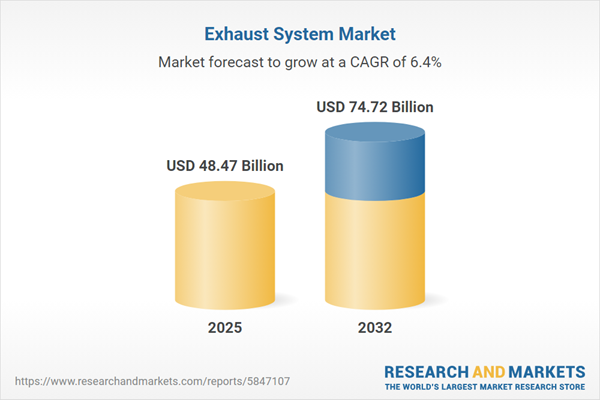Speak directly to the analyst to clarify any post sales queries you may have.
The exhaust system market is evolving rapidly as new regulations, technological advancements, and shifting mobility demands reshape opportunities and risks across the global automotive industry.
Market Snapshot: Exhaust System Market Grows with Environmental and Technological Tailwinds
The exhaust system market grew from USD 45.53 billion in 2024 to USD 48.47 billion in 2025. It is expected to maintain strong momentum with a CAGR of 6.38%, reaching USD 74.72 billion by 2032. Continued changes in automotive powertrains, reinforced emissions policies, and evolving consumer preferences for efficiency and sustainability are shaping this trajectory. Companies are adapting strategies to navigate complexity introduced by electrification, new material applications, and global supply chain realignments.
Scope & Segmentation
This research comprehensively examines market dynamics, segmentation, and geographic breadth to offer actionable insights for industry leaders.
- Product Types: Catalytic converters (3-way, diesel oxidation, lean NOx trap), exhaust manifolds (cast iron, stainless steel), exhaust pipes (downpipe, flex pipe, tailpipe), mufflers (chambered, straight-through, turbo), and resonators (chamber, Helmholtz).
- Vehicle Categories: Commercial vehicles (bus, heavy commercial, light commercial), off-highway vehicles (agriculture, construction), passenger vehicles (hatchback, sedan, SUV), and two wheelers (motorcycle, scooter).
- Distribution Channels: Aftermarket (authorized dealer, e-commerce, independent workshop) and OEM.
- Material Choices: Aluminized steel (Type I, Type II), cast iron (ductile, grey), stainless steel (304, 409, 439), and titanium.
- Fuel Types: CNG (bi-fuel, dedicated), diesel (off-highway, on-highway), LPG (bi-fuel, dedicated), petrol (gasoline direct injection, port injection).
- Technologies: Active (active noise control, variable geometry) and passive solutions.
- Regions: Americas (North America—US, Canada, Mexico; Latin America—Brazil, Argentina, Chile, Colombia, Peru), Europe, Middle East & Africa (Europe—UK, Germany, France, Russia, Italy, Spain, Netherlands, Sweden, Poland, Switzerland; Middle East—UAE, Saudi Arabia, Qatar, Turkey, Israel; Africa—South Africa, Nigeria, Egypt, Kenya), and Asia-Pacific (China, India, Japan, Australia, South Korea, Indonesia, Thailand, Malaysia, Singapore, Taiwan).
- Key Companies: Tenneco Inc., Robert Bosch GmbH, DENSO Corporation, Delphi Technologies plc, Johnson Matthey plc, Umicore S.A., Magna International Inc., Toyoda Gosei Co., Ltd.
Key Takeaways for Senior Decision-Makers
- Stringent emissions regulations worldwide are accelerating exhaust system innovation, compelling manufacturers to embed advanced catalytic and noise-control technologies.
- Hybrid powertrains and the electrification of vehicle fleets are driving fresh design imperatives, especially for seamless integration and lightweight component use.
- The adoption of high-strength steels, corrosion-resistant alloys, and titanium is enhancing durability while supporting fuel efficiency and reducing lifecycle maintenance burdens.
- Digital emissions management systems—including real-time analytics and predictive maintenance—are redefining exhaust systems as smart, connected platforms.
- Tariff measures in key markets such as the United States have triggered shifts in sourcing and manufacturing footprints, reinforcing the need for supply chain resilience and geographic flexibility.
- Collaborations, joint ventures, and acquisitions are proliferating as OEMs and suppliers pool expertise to meet new regulatory benchmarks and consumer performance expectations.
Tariff Impact and Supply Chain Adaptation
Recent tariffs on imported steel, aluminum, and select components are adding cost pressures. Manufacturers are responding by reassessing suppliers, localizing production in favorable regions, and deploying advanced cost modeling tools. The necessity for supply chain agility and risk diversification has increased in response to these ongoing trade shifts.
Methodology & Data Sources
The report employs a hybrid research approach that integrates in-depth executive interviews, structured industry surveys, and statistical correlation analysis. Multiple secondary sources, including technical journals and regulatory filings, support robust validation through data triangulation with expert feedback, ensuring accurate, actionable market intelligence.
Why This Report Matters
- Provides decision-makers with a comprehensive view of segment trends, new technology adoption, and emerging competitive strategies across the exhaust system value chain.
- Enables informed investment and partnership decisions by mapping regulatory risks, material innovation trajectories, and supply chain vulnerabilities in key global markets.
- Helps align product portfolios, R&D, and sourcing to capture revenue and margin opportunities amid ongoing powertrain and market transformations.
Conclusion
Senior leaders can leverage these insights to build resilient supply chains, invest in future-ready technologies, and maintain an adaptive posture for ongoing regulatory and market evolution. The path to sustainable growth benefits from a multi-dimensional strategy grounded in robust market intelligence.
Additional Product Information:
- Purchase of this report includes 1 year online access with quarterly updates.
- This report can be updated on request. Please contact our Customer Experience team using the Ask a Question widget on our website.
Table of Contents
3. Executive Summary
4. Market Overview
7. Cumulative Impact of Artificial Intelligence 2025
Companies Mentioned
The companies profiled in this Exhaust System market report include:- Tenneco Inc.
- Robert Bosch GmbH
- DENSO Corporation
- Delphi Technologies plc
- Johnson Matthey plc
- Umicore S.A.
- Magna International Inc.
- Toyoda Gosei Co., Ltd.
Table Information
| Report Attribute | Details |
|---|---|
| No. of Pages | 189 |
| Published | October 2025 |
| Forecast Period | 2025 - 2032 |
| Estimated Market Value ( USD | $ 48.47 Billion |
| Forecasted Market Value ( USD | $ 74.72 Billion |
| Compound Annual Growth Rate | 6.3% |
| Regions Covered | Global |
| No. of Companies Mentioned | 9 |









